“The greatest enemy of knowledge is not ignorance; it is the illusion of knowledge”
History has proved the above - mentioned quote to be very true, much before the quote caught the fancy of the modern world. This is the story of a pioneering genius who was Ignored, fired from his job, put in mental asylum & finally beaten so badly, that it caused his death. This was the way how the doctor who first advocated handwashing for its health benefits, was rewarded by society.
“Wash your hands”. That may be the earliest memories of your childhood, where your mother shouted at the top of her voice, that you should wash your hands before taking food, so as not to fall sick. One of the simplest measures to maintain hygiene, hand washing has been known for its health benefits for quite some time now.
Unfortunately, the brilliance of this simple idea was not appreciated by the people, both simple and erudite; till a few centuries back, as the doctor who first advocated hand washing (for its health benefits) discovered the hard way. Very few people know about this doctor – Ignaz Semmelweis, who was very far ahead of his time & paid a heavy price for walking a path, which at the time was certainly less traveled.

Below we discuss the Ignaz Semmelweis history, which forms a very important part of the development of modern medicine. It is mainly due to Ignaz Semmelweis’s contribution that modern childbirth has become so safe procedure as Ignaz Semmelweis’s discovery of benefits of handwashing before delivery is the main reason that women could deliver children without fear of infection & death.
Ignaz Semmelweis was born on 1st July 1818 in what is now Budapest in Hungary. His father was of German ancestry and was a businessman, who was quite well off. Ignaz Semmelweis was the fifth among 8 children, and his parents ensured that he along with the rest of his siblings get a good education.
When it came to choosing higher education, Ignaz Semmelweis joined the Law course at the University of Vienna, on the advice of his father. However, it was the accidental act of attending an anatomy class along with a medical student in 1838, that would change his life forever. Soon after Ignaz Semmelweis changed his field of study to Medicine and would get his doctorate of medicine in 1844.

After completing his graduation Ignaz Semmelweis intended to do his specialization in Internal Medicine unfortunately for him, this plan did not materialize, and instead he completed his specialization in Obstetrics, which deals with handling cases related to pregnancy and childbirth.
After becoming a trained Obstetrician Ignaz Semmelweis started working in the Vienna General Hospital where he joined on 1st July 1846. As an assistant of Professor Johann Klein, he was responsible for examining patients and supervise surgical deliveries of pregnant women, and he also maintained records of the work being done, and also taught the obstetric students.

The hospital had two Clinics/Wards for Obstetrics patients. The first clinic was managed by male doctors & medical students and the second clinic was managed by female midwives. The major problem faced by the doctors and hospital authorities of the time was – Puerperal Fever, which was also commonly known as childbed fever and was responsible for a high number of patient deaths.
Puerperal Fever in simple terms can be described as a fever that occurs because of Uterine infection following childbirth. In the modern world, we know that it is caused by bacterial infection of the upper female genital tract and associated complications. However, at the time of Dr. Ignaz Semmelweis, very little regarding this disease was known, which caused a great deal of distress for both the admitted patients and the hospital authorities.

The new maternity hospitals which developed across Europe & America in the mid 19th century promised the best of treatment by doctors, who were believed to be more well versed with the anatomy/physiology/pathology involved in the diseases and also were believed to be more competent in medical techniques than midwives.
So, it was quite shocking when a large number of hospitals across Europe & America (where doctors did the deliveries) suffered from a high mortality rate for women admitted for childbirth. Paradoxically, where the childbirth procedure was performed at home, the death rate remained even less than 1%. This greatly troubled the medical community of the time.
In Dr. Ignaz Semmelweis’s hospital also Puerperal Fever (childbed fever) was a great problem. Surprisingly, of the two Obstetric clinics present in the hospital, the one managed by the female midwives had much lower incidences of childbed fever (& associated death) than the one managed by the doctors. Somehow higher incidences of childbed fever in the clinic managed by doctors did not make any sense, and to make the situation worse even patients desirous of getting admitted in the hospital for childbirth procedure preferred the one managed by midwives.
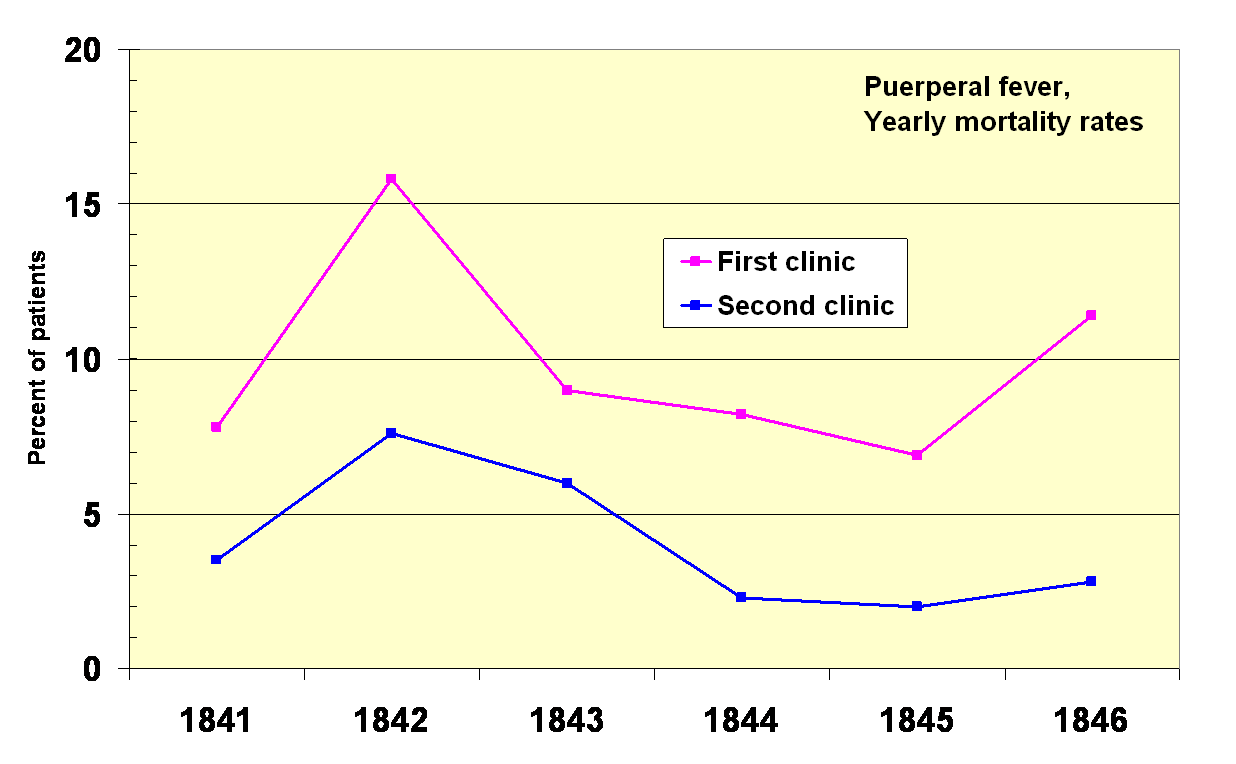
This problem perplexed Dr. Ignaz Semmelweis and he decided to devote all his time and efforts to decrease the death rate caused due to Puerperal fever in his clinic, which he did successfully but he certainly did not anticipate the reaction of the medical fraternity, that would soon arise.
The problem of childbed fever was not a new one and no one knew exactly why it occurred and how it could be prevented. However, Ignaz Semmelweis started to study the dead bodies of women who had died of puerperal fever and tried to find out what were the factors that were responsible for different death rates in the two clinics of his hospital.
The first attempt which he initiated to decrease the death rate was to instruct the women in the doctor’s clinic to give birth on their sides, as was the procedure in the midwife’s clinic (and not the standard procedure of giving birth on their back as was done previously). However, this did not decrease the incidences of puerperal fever & associated mortality in the doctor’s clinic.
The 2nd method which Ignaz Semmelweis tried to use, was based on the observation that whenever someone died in the doctor’s clinic, a priest would walk on the side of the beds of the other patients, with an attendant who would ring a bell. Ignaz Semmelweis believed that this whole incidence of a priest moving beside the patient’s beds and the sound of the ringing of a bell, made the women so terrified, that they got sick, developed a fever, and finally died of the complications. He changed the path of the priest and stopped the ringing of the bell, but there was no improvement in the death rate of the doctor’s clinic.

The failure to understand the cause of the Puerperal Fever frustrated Dr. Ignaz Semmelweis a lot, but a chance occurrence of the death of friend & colleague in 1847 would shed new light on the matter. The colleague – Jakob Kolletschka, was doing an autopsy on the dead body of a patient, who had died of childbed fever when he accidentally cut his finger and was injured. Later Jakob Kolletschka also developed similar symptoms to childbed fever & succumbed to his illness.
An autopsy performed on Jakob Kolletschka revealed that his body also showed the same pathological signs as was seen in bodies of women dying of Puerperal fever. This was an eye-opener for Dr. Ignaz Semmelweis, who realized that it was not only the women coming for delivery to the hospital, who could develop childbed fever; but other people, including male doctors, could also suffer from similar illness and die in the same way.
The fact that the male doctors were doing autopsies, while the midwives were not; would also make him realize that the doctors were transmitting something in their hands (which they acquired while doing the autopsies) to the women (when they helped in the delivery of babies), which was responsible for causing Puerperal fever. For lack of better understanding, he called these cadaverous particles or little pieces of the corpse (modern germ theory of the disease was not understood by the doctors of the time).
Many medical practices of the period, which we may find quite appalling nowadays, were followed without any qualms during that period. The doctors mostly proceeded to perform the autopsies early in the morning (midwives never participated in them), which was done surprisingly barehanded. Quite often these examinations also included examining dead bodies of women who had died of childbed fever, the day before.
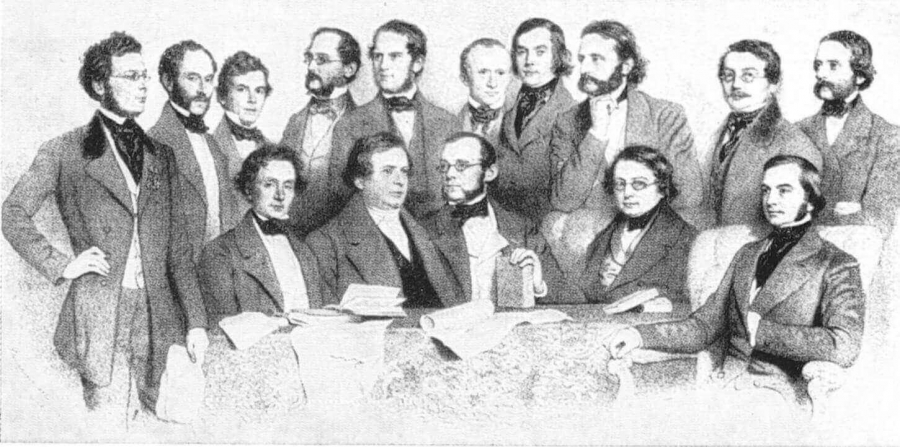
Once done with their autopsy responsibilities, the doctors later directly proceeded to take care of their obligations in the Obstetric (Maternity) ward, without washing their hands! As if not washing their hands was not bad enough, doctors of the time also didn’t clean their surgical instruments before undertaking delivery procedures.
All these faulty procedures facilitated the spread of germs from one person to another, which was responsible for highly unusual death rates because of Puerperal fever, in the Obstetric clinic managed by the doctors.
Dr. Ignaz Semmelweis realized that the only way he could test his hypothesis was by putting proper remedial measures in place & to study what changes occurred. So, he instructed the people working in the Doctor’s clinic to wash their hands & surgical instruments before undertaking any procedure, not only with soap but also with a chlorine solution.
Dr. Ignaz Semmelweis did not know, what we know today, that it is the germs that are responsible for causing diseases. He chose chlorine solution as he believed that as chlorine solution removed the smell from hands & instruments, it would also remove the cadaveric particles, which he believed were transmitted from the dead bodies (cadavers) to the admitted patients in the clinic, making them sick. However, in the modern world, we very well know that chlorine solution work as a very good disinfectant (which destroys bacteria), which is why Dr. Ignaz Semmelweis achieved brilliant results.
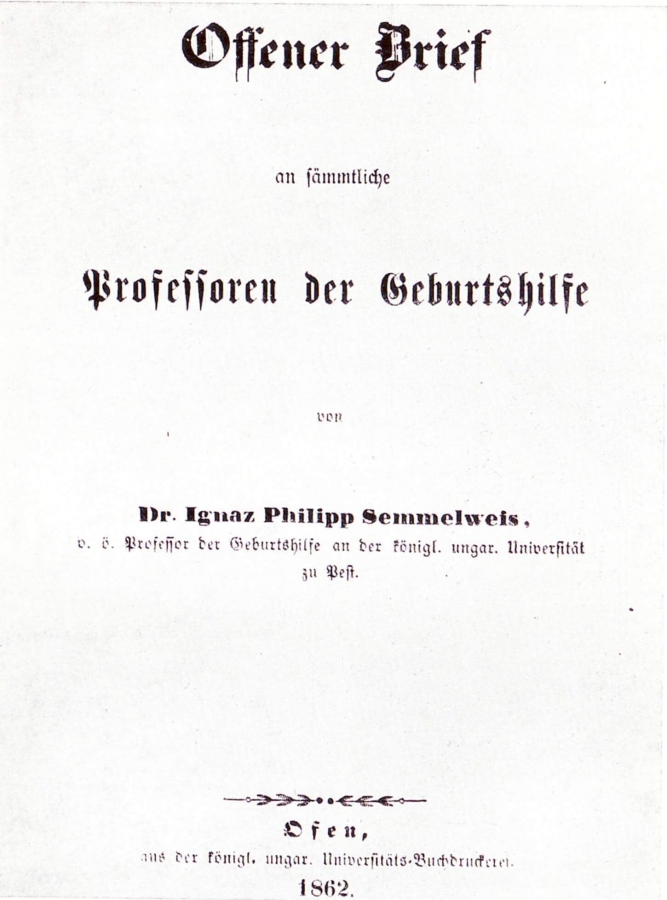
As the new procedure of handwashing & cleaning surgical instruments by chlorine solution was incorporated the performance of the First Obstetric clinic managed by doctors improved tremendously as the incidences of Puerperal fever and death because of it fell to incredibly low levels. Finally, Dr. Ignaz Semmelweis was successful in decreasing the mortality of the patients undergoing the delivery of children under his care.
By the end of 1847, the knowledge about the work of Dr. Ignaz Semmelweis began to spread across Europe. This was greatly due to letters communicated to prominent doctors by Dr. Ignaz Semmelweis and his students. The findings were also published as articles, in quite a few reputed medical journals of the time, which were written by students & colleagues of Dr. Ignaz Semmelweis.
Dr. Ignaz Semmelweis unlike many others wanted to share his secret with the whole world, so that unfortunate incidences of unnecessary loss of life due to Puerperal fever could be brought down throughout the world. He tried to inform the whole of medical fraternity how proper hand hygiene with chlorine solution can prevent Puerperal fever/childbed fever to a great extent. Dr. Ignaz Semmelweis thought that his advice would be followed by doctors worldwide, which would help save tens of thousands of lives, but he was greatly mistaken.
Puerperal fever could spread from an infected person to another, was a fact that had been known by then, due to an 1843 paper, published by Oliver Wendell Holmes (Senior) who was based in America. So, the initial response to Dr. Ignaz Semmelweis’s observations, was that he had made no new discoveries. The fact that Dr. Semmelweis had discovered how the spread of infection from all decaying organic matter to susceptible patients (& hence diseases) occurred & thus could be prevented was lost upon most authorities.
Many doctors were also furious with Dr. Ignaz Semmelweis as his findings and observations suggested that the doctors themselves were the cause of the patient’s death, as it was the unclean hands of the doctors that were declared responsible for spreading the cause of death from the autopsy room to the patients admitted in the Obstetric clinic for childbirth.

The findings indirectly also implied that the female midwives were better than doctors, when it came to the treatment of patients, as they were able to save more lives. This subtle declaration went terribly against the social norms & gender balance of the society of the time.
Even Professor Klein, his senior in the hospital did not believe Dr. Ignaz Semmelweis’s hypothesis that the maternal mortality rate had reduced due to handwashing. According to him, it was a new ventilation system in the hospital, which was responsible for the improvement, by removing the “bad air” spreading the disease. As common knowledge of germ theory of disease, was yet to occur, Dr. Ignaz Semmelweis, himself also struggled to explain his findings & justify his actions.
Dr. Ignaz Semmelweis was a brilliant doctor and a researcher par excellence but he lacked the proper communication skills and apt diplomacy, that is needed so greatly to succeed in the modern world. One of the greatest mistakes done by him was that at the initial (& most crucial) stage, most of the reports of his work, was written by his colleagues & his students; the good doctor had not published anything himself when his findings were initially revealed to the world. When Ignaz Semmelweis finally did publish his work; it was too little, too late.
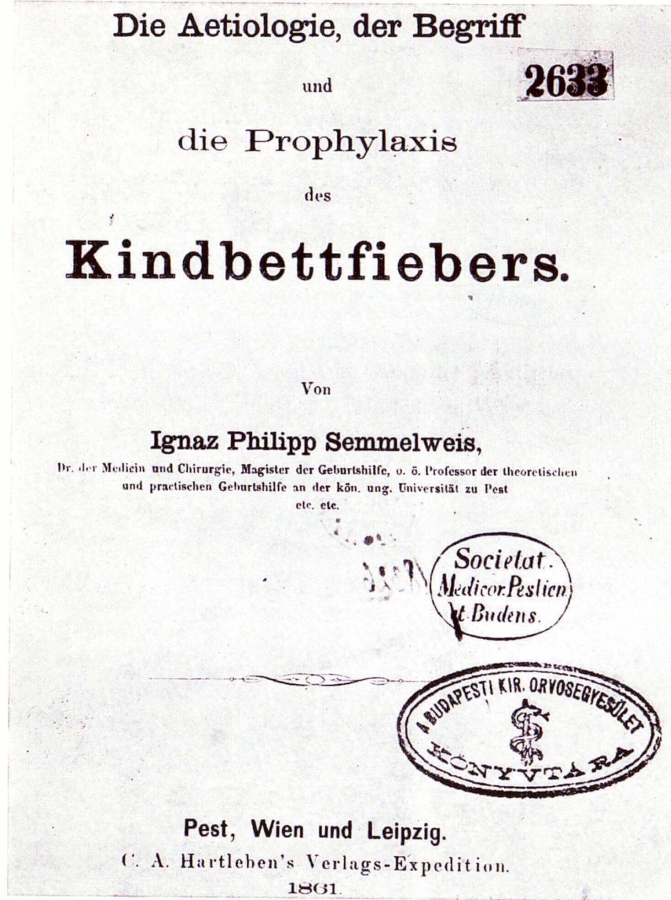
Inability/unwillingness on his part to explain his work in detail on paper caused many misinterpretations & misunderstandings in the learned circles of Europe. Many doctors did not agree with Dr. Ignaz Semmelweis, as his theories conflicted with the established medical principles & theories of the time (which later were proved to be wrong).
Dr. Ignaz Semmelweis was also not very tactful in his approach and berated the health professionals in the worst of language when they did not agree with him. Although he had good intentions towards patients in his heart, his behavior antagonized many in the medical profession and only managed to get him a few influential enemies.
Eventually, the practice of chlorine hand-washing never caught on as no one would take Dr. Ignaz Semmelweis seriously. The deaths due to Puerperal fever did not decrease as Dr. Ignaz Semmelweis had expected. To make matters worse his seniors were also very angry with him because he had repeatedly ignored their orders to stop his research & finally also indirectly implied that it was because of the negligence of these doctors, that patient’s death ensured in great numbers.
Due to the powerful enemies that he made, Dr. Ignaz Semmelweis finally lost his job. The harassment faced by Dr. Ignaz Semmelweis from other doctors, due to unwillingness to change their mindset has given rise to the term “Semmelweis Reflex” in the modern world. Semmelweis reflex means the tendency present in the people to outright reject new information or knowledge when it challenges age-old established beliefs.

As time passed Dr. Ignaz Semmelweis got angrier & bitter as he realized that ignoring his advice was contributing to an innumerable number of unnecessary deaths. Drinking heavily & going deep into depression, he started to spend more time away from his family. His behavior changed greatly and his colleagues and acquaintances accused him of strange & erratic behavior. Some believe that Alzheimer’s disease (a type of dementia) or possibly the 3rd stage of syphilis, may have contributed to his mental health deterioration.
In 1865, Dr. Ignaz Semmelweis’s wife and some of his colleagues tricked him to visit a mental asylum, without telling him, that they intended to admit him in the place. Dr. Ignaz Semmelweis had no intention of staying in a mental asylum, where he was confined forcefully. So he tried to leave the place. However, he was severely beaten by the guards present, to forcefully restrain him and put in a straitjacket.
A couple of weeks later on 13 August 1865, Dr. Ignaz Semmelweis (who was only 47 years old) died because of the wound sustained due to beating, which had later become infected & resulted in sepsis - a dangerous complication of infection in the bloodstream. In a strange twist of fate, a person who spent a great part of his life & finally lost everything, to spread awareness about how to prevent infection; himself died because of a tragic infection because of an ignoble assault.
To describe Dr. Ignaz Semmelweis as the doctor who advised handwashing, would be a gross understatement as he was much more than that. A visionary who changed the way the world looks at hygiene, the life of Dr. Ignaz Semmelweis reflects the predicament faced by mankind since ancient times.
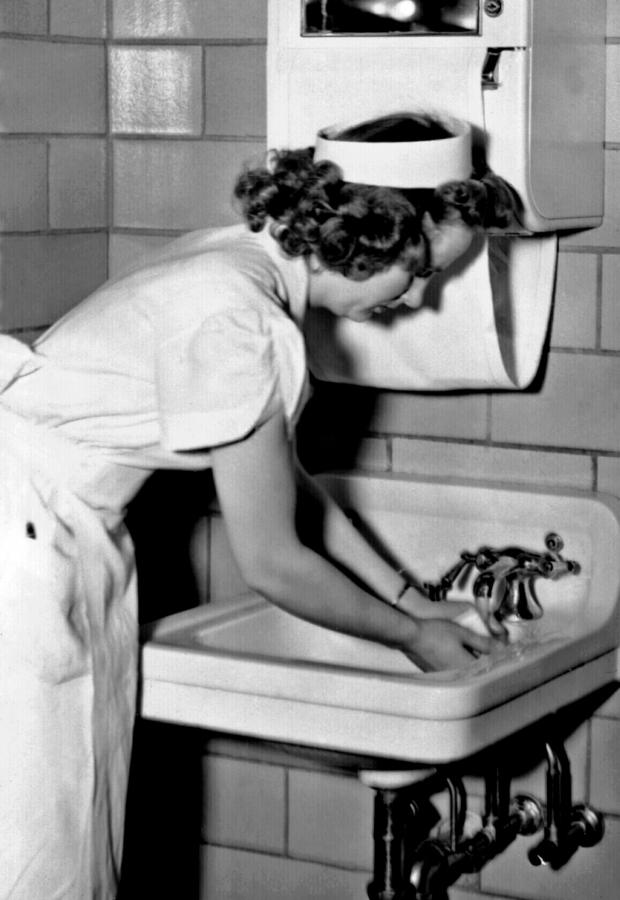
Dr. Ignaz Semmelweis’s failure was mainly due to the absence of the knowledge that diseases like infections were caused by microscopic organisms, that may die by using disinfection procedures. However, a few decades after Dr. Ignaz Semmelweis’s observations, the French scientist – Louis Pasteur, was able to prove the germ theory of disease, which would go on to change radically the medical scenario.
All of a sudden, the missing piece in Dr. Ignaz Semmelweis’s findings fell into place and by the late 1800s, surgeons & other doctors were routinely washing their hands before examining a patient or undertaking surgery. However, unfortunately, Dr. Ignaz Semmelweis was no longer alive to see that his teachings were now followed by all health professionals, the world over.
The people all over the world now know & recognize the health benefits of handwashing, but few people know about Dr. Ignaz Semmelweis’s contribution towards this great development. While we take a million small things around us as granted in our everyday life, sometime we should pause a little to learn and reflect on the lives of many of these forgotten great men & women, who strived for the betterment of human life, even when they received only scorn & humiliation from the society, for which they sacrificed so much.
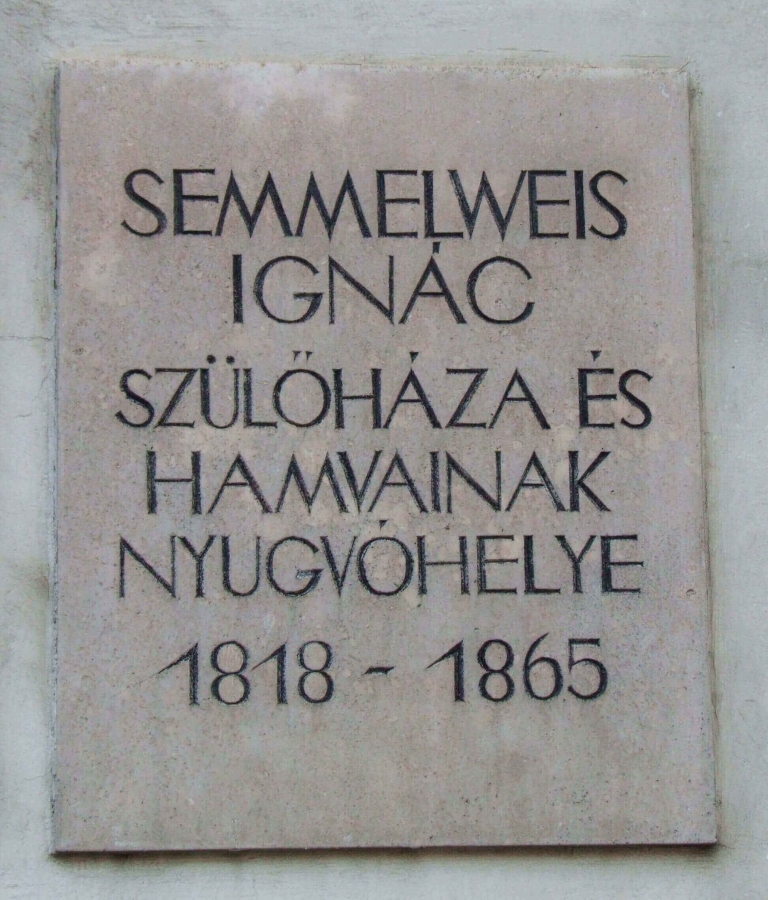
Must Read About: Typhoid Mary